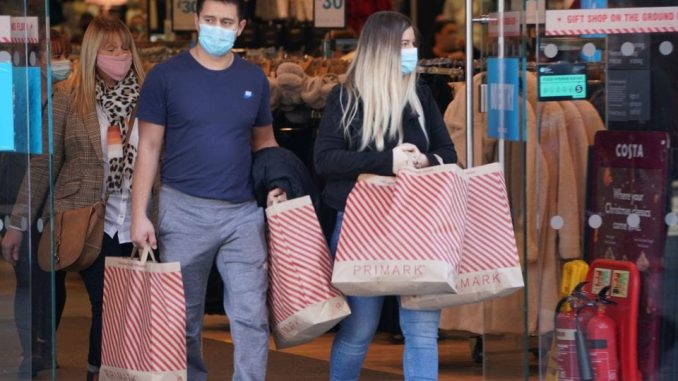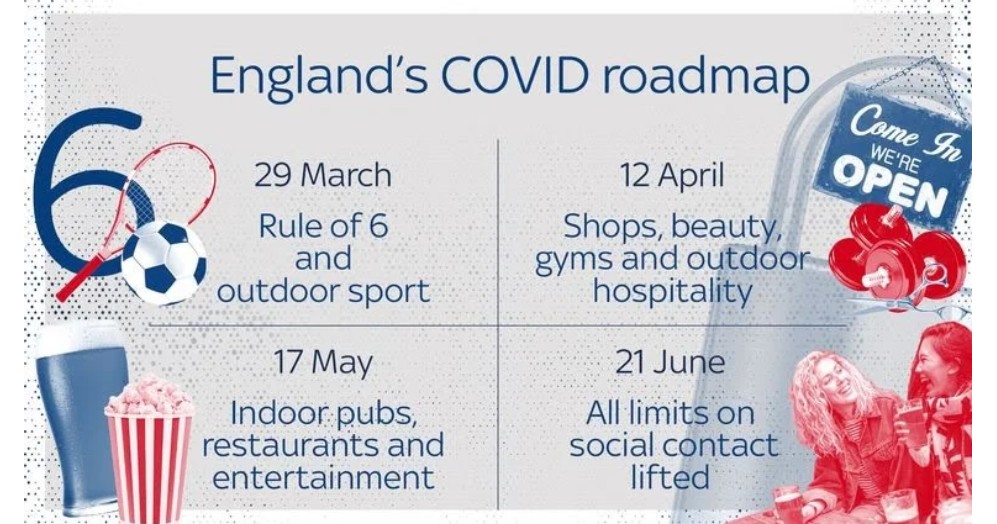

Only essential shops have been allowed to remain open under the latest Covid lockdown, which include supermarkets, DIY stores and pharmacies.
The reopening of the high street is part of phase two of the PM’s roadmap – and stage one is nearly over, which started on March 8 when schools reopened.
Today, outdoor sports facilities, such as swimming pools, reopened and the Rule of Six returned, allowing six people from up to six different households to mix outdoors.
However, the roadmap is dependent on coronavirus cases staying under control and the vaccine rollout staying on target, The Sun said.

When non-essential shops can reopen in mid-April at the earliest, shoppers will have to follow rules when in stores.
Although official guidance hasn’t been published yet – but its likely that retailers will need to put in place strict measures to keep shoppers safe in stores.
From longer opening hours to wearing masks, we explain nine rules that the high street is expected to follow when it reopens, based on current guidance and what shops did last year:
1. Hand sanitiser stations

When the high street opened for business again in summer last year, hand sanitiser was readily available for shoppers to use.
It will more than likely make a reappearance again this year.
Hand sanitiser stations are still a main feature in essential stores that have remained open under the third national lockdown.
For example, Asda has increased the number of hand sanitiser stations around its shops, and they are also in many other supermarkets like Tesco and M&S.
For example, many pubs who are gearing up to reopen in mid-April are making sure hand sanitiser is readily available, such as Wetherspoons.
2. Cleaning in stores – day and night
To curb the spread of Covid, essential retailers are having to keep shops extra clean – and it is likely non-essential shops will have to do the same.
In supermarkets, the tills are frequently cleaned as well as baskets and trolleys, and non-essential retailers will be expected to do the same.
Rigorous cleaning schedules will have to take place throughout the day and after stores close to make sure shops are spotless.
Last year when non-essential businesses were allowed to reopen, stores were spending the equivalent of an entire working day a month doing extra cleaning because of coronavirus.
Prior to the pandemic businesses typically devoted 32 minutes a day to sanitation, but it rose to 51 minutes during the pandemic.
3. Fitting rooms might close
Although the government hasn’t confirmed whether fitting rooms will remain closed when the high street reopens, shoppers might not be able to try before they buy.
Last year when shops reopened in summer, fitting rooms remained closed to help limit the spread of Covid.
Shop workers weren’t allowed to help shoppers try on items.
In cases where fitting rooms were essential – for example, for key workers trying on essential protective clothing – retailers had to clean them between each use.
4. No testing products before purchasing
You probably won’t be able to try on any products before you buy them.
Essential retailers like Boots have already removed make-up testers from shop floors, and non-essential stores selling make-up will most likely have to follow suit.
However, some stores last year were letting customers try some items before buying.
JD Sports and Schuh let customers try on shoes last year – although they were cleaned after each use.
And some opticians are letting customers try on glasses – but these are cleaned before they are put back on the shelves again.
It’s best to check with a member of staff to see what you can and can’t do if you’re unsure.
5. Signs in stores explaining rules

When non-essential retailers can reopen, they will have to put in measures to ensure that social distancing measures are kept to by customers in stores.
This means that shoppers may have to follow one-way routes around shops, so look out for signs, stickers and posters in stores explaining the rules to follow.
Betting shops like Coral also introduced sneeze screens between gaming machines to make sure punters kept a distance – this might also be in place this time around.
6. Social distancing

Shoppers raced to queue outside their favourite stores before opening hours and it looked like the Boxing Day sales insummer last year when non-essential shops reopened in June.
This time around, stores will also have to keep strict social distancing measures in place.
It has been reported that under proposed Government rules, people will have to stay two metres apart from each other until at least autumn.
Some scientists believe that these restrictions may need to be in place until the end of the year.
Social distancing measures in essential stores were tightened up in January and have remained in place ever since.
Ministers told councils to place limits on the number of people allowed into shops at any one time.
7. Longer opening hours
Last week, Communities Secretary Robert Jenrick announced that shops will be able to open for longer when they welcome shoppers back in mid-April.
They’ll be able to open until 10pm at the latest six days a week, apart from Sundays, in a bid to make shops less busy at peak times to help and ease transport pressures.
However, it’s best to check ahead with the store you’re planning on visiting, as they might choose not to open this late.
8. Limits on numbers in stores

With social distancing on the cards until at least autumn, shops will have to make sure that customers are keeping two metres apart at all times from each other.
This will mean that shoppers will have to prepare to queue outside before they can get in the store.
Shoppers are already having to queue to get inside essential shops, which are still open under lockdown.
For example, Aldi operates a traffic light queuing system where customers can only enter the store if the light turns green at the shop’s entrance.
9. Wearing masks
Government rules state that Brits must wear masks when shopping – which includes walking around shopping centres and malls – unless they are exempt.
When non-essential retailers reopened for business last year, many shop workers greeted staff at the door reminding them to wear their face masks.
Brits might have to wear masks until 2022, according to some experts.
Professor Neil Fergusn, who played a big role in shaping the UK’s first national lockdown, said that masks might not be ditched until Autumn this year at the earliest.
Others, like former supreme court judge Lord Sumption, think it could be another 10 years until Brits are freed of masks.
Shop workers will also have to wear masks too.




Brits will be able to hit the shops in just under two weeks, as the nation gears up for stage two of Boris Johnson’s lockdown roadmap.
As part of Boris Johnson’s four-step plan to get Britain back to normal again, non-essential shops can reopen from April 12.